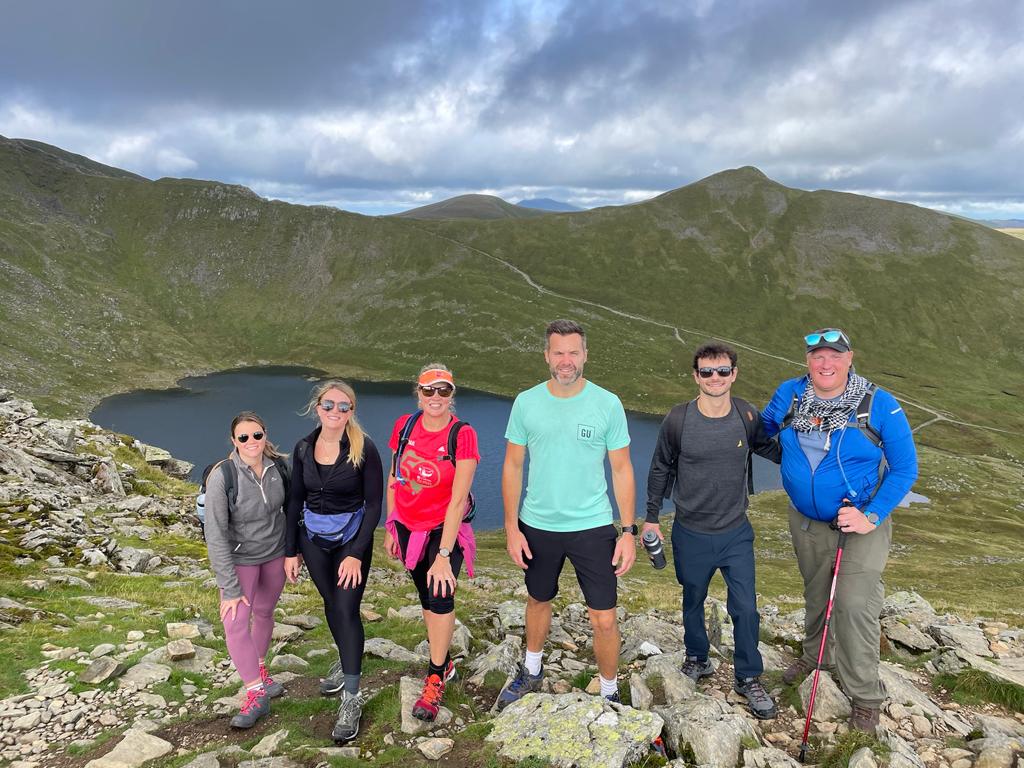People
How is ESG Recruitment like climbing a mountain?

So let’s get the humblebrag out of the way early. The Farrell Associates team climbed the second highest mountain in England, Helvellyn in September to raise money for charity. This was important for us as we primarily did it to support our colleague, Steph who lost her best friend to cancer earlier this year.
So off we went to Cumbria – easy for me; just 2hrs on the M6, turn left, stop when I find Ullswater. The rest of the team had a variety of international odysseys, navigating the UK’s rail network or driving further.
Climbing a mountain always seems easy at the bottom. The path winds gradually along a river, through a gate or two, a mixture of asphalt and even terrain.
The gradient is almost imperceptible. You chat, take photos, laugh, take in the views, which at this stage are green and lush with trees, meadows and bubbling brooks.
Then you start to notice that the climb is starting to feel a little more strenuous. The steps are farther apart. There are no undulations. Just up. The pretty view is behind you. The view in front of you is a crude, uneven rock pathway. Up you go, some faster than others. You stop laughing quite so much. You start to sweat and feel uncomfortable. You have to watch your footing. Your world becomes one foot in front of the other, picking a path, making that mental decision between the longer, easier path of least resistance, versus the more strenuous, steeper but more direct route up.
At this point you cannot see the summit. You know it’s there, but your brain and body cannot conceptualise the task ahead, only that the task requires forward momentum.
Depending on your age and state of fitness, there comes a point, sooner or later where it starts to hurt. Your knees burn. Your lungs feel half as capacious as you want them to be. Your hamstrings start to tighten. Lactic Acid replaces adrenaline. Mentally, you start to wonder why you are doing this. You look back, and feel surprised at how short a distance you have covered. Part of you wants to quit. This isn’t for you. But on you trudge, up, up, up.
At these points the people you are with are vital. They raise your spirits, set or moderate the pace, encourage you to take on fluid and food, and crucially, navigate. All you can see ahead is the journey. It is winding, and the higher you get, the more featureless it becomes.
With most mountains I have climbed (well big hills, I’m not exactly Edmund Hillary), there comes a point where you can see the summit. It can look impossibly far away. By this point, gone are the trees and lush pastures. The streams are now small fingers of flowing water. It is barren, and rock, and brutal in it’s beauty. Depending on your mindset, it can either feel exciting to have the peak in view, or demoralizing knowing that it’s still so far away.
As you begin the hike to the summit, everything changes. The temperature changes. The wind increases. The path is not defined. There are parts you have to plot, rock by rock. It is easy to get this wrong, and find yourself on the wrong side of a gap, or with a awkward foothold. By this point your legs are tired, and your feet can feel bruised. On Helvellyn there is a famous ridge called Striding Edge. It’s an inspiring place. You feel on top of the world. But it’s also brutal. There is a point where you have to weigh up whether you should go on, or turn back. For those with vertigo, it can make you freeze. You have to descend vertically, backwards in places. If you lose your footing, well if your phone has reception, you’ll be calling mountain rescue.
The final ascent to the summit is hard and fairly technical for the inexperienced climber. It’s also exhausting. Your legs burn. You can easily cramp up. You climb with hands and feet. Looking down is a bad idea.
The summit, naturally is glorious. You can see for miles and get a great sense of achievement. And then you have to get down again…..
What has this got to do with ESG Recruitment?
Well sometimes building a shortlist to hire great people within a challenging and often technical space is like climbing a mountain. A very big one. We don’t know where the top is until we start walking.
There are times where it’s hard, repetitive and difficult to feel like you’re going anywhere. To find great people often requires mapping a path where no prior blueprint exists, particularly within emerging disciplines.
The higher you go, the harder it gets, and the less defined the path and the more you need to lean on the expertise of others, and trust information you might not be able to conceptualise. You have to stride ahead with conviction, meet a lot of people, many of whom may not be right for the mandate you are working on.
It might require stopping, going backwards and re-plotting the route, changing the search parameters and headhunting different people. You might have your progress hindered by economic storms, or delays in budgetary and headcount sign-offs.
The further you go, the more scarce the people can be, and the more difficult it can be to engage with them. There will be people who freeze and turn back, or slow down the search process.
It is frustrating and will test your judgement in interviews. When there are too few available candidates, you may be tempted to ‘make do’. When there are too many, it’s easy to choose the wrong one. You may want more support than you are being given.
The cold hard reality is that a great hire may not revolutionise your department and give you the answer to the questions you have been posed straightaway. However once you’ve made the decision drive forward, what is nearly always true is that every step forward has value. Just through the interview process alone, you may meet people who change your perspective of give you insight you didn’t know you needed. That new hire may well come with experience that becomes valuable in the future rather than immediately.
It might not be apparent now, or even in the foreseeable future, but just because it’s above the cloud line and your legs are sore, doesn’t mean that it’s not vital to keep climbing.



